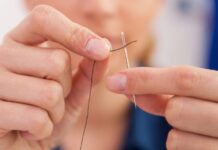1. How to Choose the Best Pig’s Trotters
There are two types of pork trotters: front and hind legs. The front legs are shorter, and those in the know opt for these as the meat is more tender, softer, and has a thin layer of fat. This is because pigs primarily use their front legs for movement, so the meat quality is superior. The hind legs, on the other hand, have larger bones, resulting in a bigger overall size. Additionally, as the hind legs have less movement, the lean meat is relatively thicker and tends to be a little drier.

The meat of the front and hind legs is easily distinguishable. Front leg meat consists of one-third fat and two-thirds lean meat, whereas the hind leg meat has more layers and a squarer shape.

Notes on buying pork trotters:
- Choose a firm, meaty trotter with even muscle fibers. The cut surface should be dry, and when pressed, the meat should be resilient.
- Opt for trotters with a fresh pink color and no unusual markings. The cut surface should have a natural, bright, and dry appearance. The meat should be free from any unpleasant odors or strange particles.
2. How to Select the Best Pork Ribs
There are two types of ribs, and they are both delicious. When choosing, keep the following in mind:
– Loin ribs: These ribs have larger bones and less meat. The meat layer is thin but relatively tender and aromatic, making it ideal for stewing, braising, or sweet and sour stir-frying. It also looks beautiful.
– Tail ribs: This part is very tasty, with a good mix of fat and lean meat, making it tender and perfect for soups.

Pork ribs are considered one of the most delicious parts of the pig. However, there are differences between the various rib sections. Knowing how to choose the best ribs will ensure your dish turns out perfectly.

Not only are ribs highly nutritious, but they are also considered one of the tastiest parts of the pig. According to experienced butchers, pork ribs can be divided into three main sections: front (near the front legs), middle, and back (near the hind legs). Each section has unique characteristics in terms of tenderness and flavor. Depending on the dish you want to prepare, you should choose the appropriate rib section.

The front section of the ribs has longer and harder cartilage that runs along the bones. Those who enjoy eating cartilage should choose this section for their dishes.

Another distinctive feature of the front ribs is that the meat surrounding the bones is quite soft and elastic. While there is some good meat on these ribs, the layer is very thin and sparse. The front ribs also have a relatively low amount of marrow. Therefore, front pork ribs are not suitable for making soup. Instead, they are ideal for dishes like stewing, braising, salting, and sweet and sour pork ribs.

The middle section is considered the most desirable part of the ribs. The ratio of cartilage, meat, and marrow in this section is extremely harmonious. It is suitable for almost all rib dishes, especially the more intricate garlic-grilled pork ribs, which typically use this section.

Compared to the middle section, the back ribs are not as premium, but they have their unique advantages. Specifically, they contain a lot of marrow, and while the meat is thin, it is firm, sweet, and slightly chewy, making it perfect for soups or stews.

While the middle section is easily identifiable, the front and back sections can be challenging to distinguish. Butchers reveal that you should pay attention to the following points:

In terms of color, the front section is usually the darkest, while the back section is typically lighter.

Regarding shape, in addition to having a larger amount of cartilage and less meat, the front section is also thicker and shorter. Conversely, the back section has more meat and a lower bone density.

In addition to selecting ribs by their position, you should also pay attention to their smell, color, and elasticity to determine whether they are fresh or have been stored for a long time.

Fresh ribs usually have a fishy smell but not a putrid one. They should have a bright red or light pink color on the outside. When you press on the ribs with your finger, the meat should indent and then quickly return to its original shape.

If the ribs feel soft and mushy, have an unpleasant odor, are discolored, or lack resilience, do not purchase them. Using stale ribs not only affects the taste of your dish but can also be harmful to your health.
Web design and development expert with over 15 years of experience. I have helped hundreds of businesses with their website development strategies to ensure sustainable growth and profitability.































